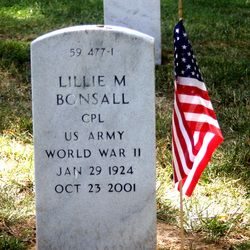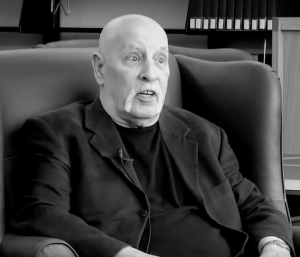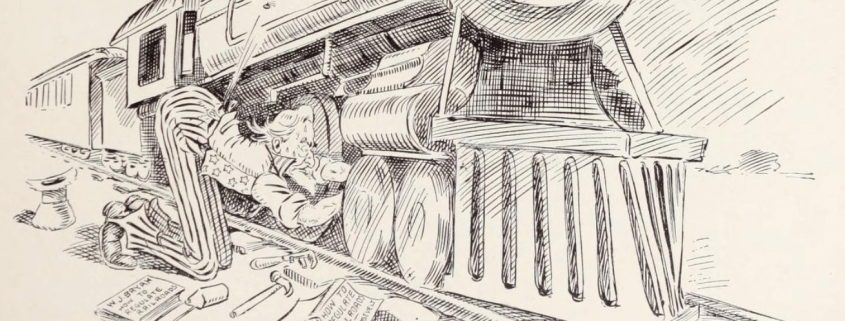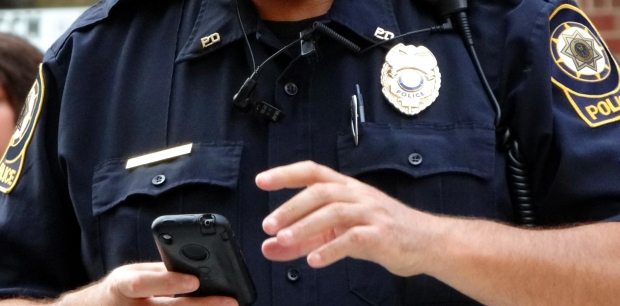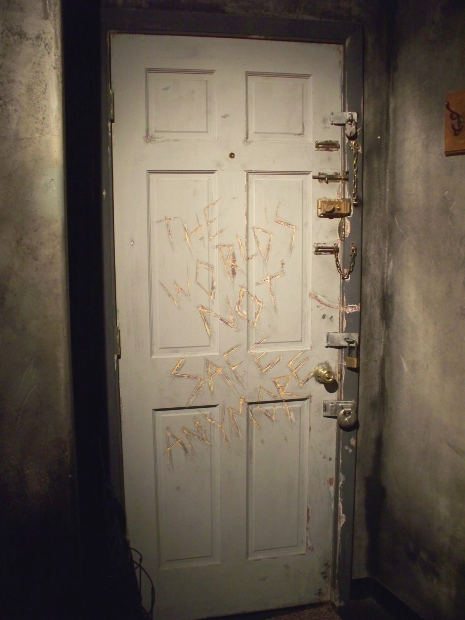Officer Ronald Tarentino, Jr., 42
Auburn Massachusetts Police Department
May 22, 2016 – Officer Ronald Tarentino was shot and killed while conducting a traffic stop. As he approached the car a man immediately opened fire, striking Officer Tarentino numerous times.
The suspect fled the scene but was later determined to be hiding in an apartment. When officers entered the residence they discovered a secret passageway leading to another apartment. As officers were searching the second apartment the suspect exited a closet and opened fire, wounding a trooper. The suspect was killed during the exchange of gunfire.
Officer Tarentino is survived by his wife and three children.
Les Edgerton served a little over 2 years in Pendleton in the sixties on a 2-5 burglary charge (plea-bargained down from 82 counts of second-degree burglary, a count of armed robbery, a count of strong-armed robbery, and a count of possession with intent to sell). When he was in the joint, then-President Johnson declared Pendleton to be “the single worst prison in the U.S.” Les agrees with that assessment…
Since then, Les has earned a B.A. (With Honors of Distinction) from Indiana University and an MFA in Writing from Vermont College. He has published 18 books, taught creative writing at various universities, including the UCLA Writer’s Program, St. Francis University, and served as Writer-in-Residence at the University of Toledo and at Trine University. His work has been nominated for the Pushcart Prize, O. Henry Award, Edgar Allan Poe Award (short story category), PEN/Faulkner Award, Jesse Jones Book Award, Violet Crown Book Award (was awarded a Special Citation for his novel The Death of Tarpons), and others. A screenplay of his was a semifinalist in the Nichol’s Foundation Awards. The NY Times review of his story collection, Monday’s Meal, compared him favorably to Raymond Carver.
Currently, he resides in Ft. Wayne, IN with his wife Mary and their son Mike. Les has two daughters-Britney and Sienna-from a previous marriage. He teaches online classes for Writer’s Digest and provides novel coaching services for writers.
Les says, “When President Johnson came on TV to announce the results of his administration’s study that “Pendleton was the single-worst prison,” I was watching over in J Block and everyone stood up and began cheering and waving aloft a single digit. It was like our football team had just been named Number One. Quite a stirring experience. We knew then how Notre Dame fans felt…
ACCURACY IN CRIME NOVELS
(Depicting the criminal’s mind and behavior accurately)
I’d like to address a subject that’s bothered me for many years. I’m speaking of the way authors have routinely depicted the average criminal’s mind and behavior, which, in the main, have been largely inaccurate.
First, to establish my “bona fides” I am both a writer and an ex-con, having served about two years of a two-to-five sentence in the Indiana state prison at Pendleton, Indiana (for second-degree burglary) back in the sixties. I was originally charged with 82 burglaries, one count of armed robbery, one count of strong-arm robbery, and one count of possession with intent to deal. All of the charges were reduced to a single count of second-degree burglary via a plea bargain. I actually committed far more felonies-for instance, I did over 400 burglaries-but 82 was all my rap-partners could remember (or were in on-many I did solo) to roll over on me on-and so that’s the number I was charged with. The statue of limitations has run out on them now, so I can “fess up.”
One of the basic elements of good writing, in my opinion, is veracity. Not only should the author remain true to his personal version of truth, but his reportage should also be accurate. And, in the case of the criminal mindset and normal behavior, I see instance after instance in short stories, novels and movies where an inaccurate portrayal is the rule and not the exception.
Let’s look at three of the most common inaccuracies:
1. Inmates in prison hate child molesters.
Mostly hooey. It seems to be common wisdom these days that people on the bricks (“straights”) believe that inmates in prison hate child molesters and can’t wait to kill them. I disagree… to a point. Back in my time in prison (mid-sixties in a state joint, which is vastly different than a federal prison), nobody much cared about what you were in for. Actually, there weren’t many child molesters back then-child molestations, while they’ve always been around are infinitely more common these days than back then-but as long as they minded their business no one really bothered them or cared what they’d done. I can only remember knowing of one inmate who was a convicted child molester and nobody bothered him or much cared what he was in for. To be honest, a large number of people incarcerated have drinking or drug problems and when they’re on the sauce or high, pretty routinely abuse their own kids.
2. Inmates hate convicted cops.
Again, hooey. The few cops that were in the joint with me had more friends than anyone else, on average. The thing is, cops and outlaws interact with each other all the time on the bricks-at least the professional criminals do-and most of us like and even respect each other. There’s a very fine line between being a cop and a criminal, in my opinion. We’re both adrenaline junkies and is one of the chief reasons we become what we are in these two “career fields.” When I was “in the life” I used to hang out almost every night at a slop shop in downtown South Bend, before I went to “work,” and half the people there were off-duty cops and half were outlaws. We all got along well and if one of those guys got sent up, we were still friends.
3. Inmates claim to be innocent.
This is probably the biggest myth of all. Nobody claims to be innocent in the joint-even those few who are. If you were innocent and said so to other inmates, they would take that as a sign of weakness and you’d be in trouble. Where that comes from is when a reporter or researcher interviews an inmate, very often they’ll sing him a sad tale of woe about being bumrapped. The reason is, no matter how guilty the person is, once you’re inside, all hope has vanished. To be interviewed, especially by a sympathetic listener, the hope rises that enough bleeding hearts will read the article or see the show and be moved to do something to get the guy liberated. That it doesn’t happen doesn’t destroy the hope-they know it’s a long shot anything like that will happen, but it’s a glimmer of a hope and so they bring their acting chops to the table-probably even claim to have one of those b.s. “jailhouse conversions” and hope somehow their “story” (and that’s usually what it is-a story-will affect the right people’s hearts and a miracle will happen. I only knew one person when I was in who was truly innocent and there’s no way he would have claimed that to other inmates unless he really trusted they wouldn’t tell anyone else. That’d be suicide. In fact, when those who appear in documentaries and TV shows claim their innocence, the instant they’re back in the cellhouse they make sure to let everyone know they were just pulling a shuck.
Another thing they don’t publicize as it would destroy the common misconception. Of all those people who get freed from prison after an investigation or new trial, probably 90-some percent aren’t freed because they were found innocent. They’re freed because of a legal technicality. You can look that up.
For points #1 and #2, what I suspect has happened to lead to the hatred for child molesters and cops inside the walls is what has happened in just about all the instances of misconceptions about convicts. I think what’s happened is that movies romanticized this (inmates hating and killing child molesters) and inmates bought into this image of themselves for a variety of reasons–a typical reason being that people in prison are just plain looking for any kind of excuse to shank someone and this is as good a reason as any and even kind of makes the guy shanking a child molester look like a good or moral guy.
This is exactly what happened with Mario Puzo and his book and subsequent movie “The Godfather.” Puzo admitted he knew nothing at all about the Mafia and made up nearly everything about them that’s in his book. This guy was living in a suburb in Connecticut-sitting in his garage typing on a door laid out over two sawhorses-and had never even seen a mafiosa up close. What he was familiar with were insurance executives and stock brokers. Just about everything in the book was fabricated out of whole cloth.
The truth being, most Mafioso aren’t all that bright and are basically street thugs with fairly low I.Q.’s in general, but the movie glamorized and romanticized them with horse’s heads and “sleeping with the fishes” and “hitting the mattresses” and all the other stuff Puzo made up, so they just adopted the whole thing because it made them look much cooler than they actually were and are. Life imitated art. There’s just an awful lot of that going on in the public’s general
perception of inmates and prisons.
The same thing happened with the cops being in danger in the joint myth. Some individual somewhere told a reporter that and the naive reporter (there’s a lot of those folks!) reported it as gospel and just like the child molester myth, that just gave cons an excuse to shank someone and feel “moral.” Now, of course, thanks to television and the movies, convicted cops are in danger.
The problem is, the vast majority of inmates in state prisons are operating with an average fourth-grade education and so aren’t likely to write screenplays or books (most can barely read), so the public only knows what a reporter or researcher tells them and inmates are almost never straight with them for all the above reasons and more. Ex-cons from federal joints are better-educated and sometimes do write articles and books, but the problem is federal joints are as different from state joints as a rowboat is from the Queen Mary. The next time I do a crime I’m going to do something that qualifies for a federal jolt first and then if I’m busted for something I’d do state time for, I’ll cop a plea on the federal beef and end up going there first, which means I’ll probably die in a federal prison before I do the state bit. Federal time is just a wee bit easier to do…
If you’ll have me back, Lee, I’ll tell the story of the period Charles Manson and his cellmate in Corcoran, Roger Smith (who bills himself as the “Most-Stabbed Inmate in History”-which he probably is-he’s been shanked over 300 times) kept calling me for a month to chat and with Roger begging me to write his autobiography and what happened then.
Thanks for having me!
Blue skies,
Les
P.S. Of the thousands of novels and movies I’ve experienced, the only time I’ve seen the criminal mind portrayed accurately (imo) was in the scene in Pulp Fiction where the guy shoots his best friend in the back seat of the car by accident. His reaction is the only honest depiction of the criminal mind I’ve yet seen.
~
Les Edgerton’s Hooked –The first and only fiction-writing book that focuses exclusively on beginnings–no other book on the market addresses story beginnings in a comprehensive manner.
Visit Les here.
~
One of my favorite Les Egerton quotes:
“I’ve got an MFA and I’ve also got a barbering certificate from Pendleton where I was in the joint, and of the two the barbering certificate’s made me a lot more money. ~ Les Edgerton”
*Note to writers – If you EVER have the opportunity to hear Les speak do yourself a favor and drop what you’re doing and go there as fast as your feet can take you. He’s an incredible (and hilarious) speaker and teacher. He’s also a great guy and I’m proud to call him my friend.
All Aboaaarrrd!!
Before we begin, let’s all stand to sing a few verses of the Anycity Transit Authority’s brand new theme song. Leading us today is train conductor I.M. Listnin.
Is everyone ready? Oh, by the way, it’s to the tune of the theme song of the 60’s TV show Petticoat Junction. In case you’ve never heard the song…
Okay, let’s count it off!
1.2.3. And off we go…
Come ride the little train,
that is listening to your words,
it’s their function.
Forget about your rights,
it is time to submit,
it’s their function.
Lotsa ears, you bet.
Even more, when you get,
to New Jersey.
There’s a scary old thing,
called the Big Brother,
it’s their function.
Government Function.
It is run by Feds,
come and be their guests,
at the prison.
Government Function.
And that’s Agent Joe,
he’s a listening to your words,
it’s his function.
Government Function.
All right, here’s the scoop. In addition to the video recording devices we’ve all become accustomed to seeing everywhere, and I do mean everywhere, including on public transportation (buses and trains), authorities are stepping up the surveillance game by adding audio recording capabilities.
That’ right, officials are now recording your conversations. In case you didn’t catch that, I’ll repeat it. Government officials could be/are listening to your private conversations.
Those of you in New Jersey who use the light rail to commute between Camden and Trenton…yep, the audio recordings are happening right now.
Actually, New Jersey Transit is just the tip of this audio-spying thing. Maryland Transit Administration also records conversations of their riders. However, they say they rarely listen and most likely delete conversations after holding the recordings for 30 days or so. The purpose of the audio, they say, is in case they need it to investigate specific “incidents.”
Other areas where both audio and video recordings are used on public transportation include California, Virginia, Oregon, Michigan, Ohio, Connecticut, Georgia, and New Hampshire. (1)
In the state of Washington (a beautiful place, by the way), all King County Metro buses equipped with video surveillance are also equipped with audio surveillance.
The recording systems are a step above the typical recording devices in that those who listen in have the capability of filtering out background noises and to zero-in on a specific conversation. The audio and video sync together which enables the technician to watch and listen at the same time. And, all of this could be done in real time since the onboard black box transmits wirelessly to the command center.
The cost to purchase and install the audio surveillance systems is provided by grants via Homeland Security, and this stuff is not cheap. For example, it cost $1.9 million to install them on New Jersey’s Hudson-Bergen and Newark light rail trains. Another $750,000 to install them on River Line trains. (Source – NJ.com)
Add this to the growing list of ways the heroes and villains of your stories can track one another and to listen and watch their foes as they move about between the pages of your latest book.
Or, fictional hackers could alter a recording of your train-riding hero by inserting things she didn’t say, such as making it appear that she confessed to a murder she didn’t commit, or one she was “plotting” with a conspirator. How’s that for a plot twist?

(1): Source – ACLU, Washington, D.C.
Other information – NPR, and my own personal knowledge.
There are many rules in the world of cops and robbers, both written and unwritten. Writers, of course, enjoy the freedom of making things up as their stories progress from one scene to another. However, a touch of authenticity sprinkled throughout the pages adds a nice touch to well-crafted tales.
Here’s a light dusting of reality for the heroes of your twisted tales.
Toilet Training for Cops
1. Do not cover the body of a murder victim with, well, anything found at the scene. This means NO sheet, NO blanket, etc. And DO NOT use your hero’s personal items (jacket, sweater, etc.) to shield the murder victim’s face from the view of the growing crowd of looky-loos.
Covering the victim with any potentially contaminated item could transfer trace and other evidence from the material to the body, and/or it could transfer evidence from the body to the item. Trace evidence could also be brushed off the body during the placement of a covering.
There are items designed specifically for this situation, including body sheets that can also be used for placement of crime scene investigation tools, kits, etc. Setting these items on a sterile sheet or blanket prevents contamination.
However, if your hero insists upon covering the victim with something found at the scene, have her/him leave it with the body when transporting to the morgue. The M.E. will know what to do with it when it arrives. If the covering is removed prior to transport, package it and send it along to the lab or morgue for trace evidence examination.
*Writers – using something from the scene, a jacket, a beach towel, etc., could definitely wind up implicating the wrong person as the murder suspect. The innocent party could have used the towel which, in turn, caused their DNA to transfer (tertiary transfer) to the victim’s body. Red herring #1.
2. It IS possible for DNA evidence to transfer from one article of clothing to another when washed together in the same machine. Avoid tunnel-vision and consider the possibility that the DNA evidence could be pointing to the wrong person. So have your heroes build their cases with multiple bits of evidence, not just DNA found on freshly washed clothing in an apartment shared by six roommates. Besides, the DNA testing process is not 100% foolproof.
3. Broken glass at the scene of the crime? Have your hero check the soles of the suspect’s shoes for tiny bits of glass. It’s possible to match them to glass found at the scene.
4. Did you watch the Jack Reacher movie? If so, you saw the investigator straighten a portion of a paperclip and use it to pick up a spent bullet casing (brass). This is a great way to collect brass without destroying fingerprints. After all, the shooter had to use his/her fingers to load the rounds, right?
5. I’ve been known to preach, “Do not use TV as a research tool! The job is not accurately portrayed on the small screen.” Well, there is one instance where TV works to an officer’s advantage. Almost always, TV traffic cops approach a stopped vehicle from/on the driver’s side. This, like the CSI effect has people believing what they see on episodes of CSI Wherever, has the majority of TV watchers expecting what they see on their favorite television shows—officers coming to them on the driver’s side of the car. Therefore, when officers approach from the passenger side, the occupants of a vehicle are caught off guard. I highly recommend the passenger side approach for two reasons, the aforementioned element of surprise, and the officer stands a better chance of not being struck by passing motorists.
6. Don’t use bare fingers on light switches and other on/off buttons, knobs, toggles, etc. Likewise for their protective plates. These are prime spots for the retrieval of fingerprints. In fact, before touching a switch your hero should make a note regarding whether or not the lights were on or off when police arrived. If they arrive during daylight hours and the lights were found on, well, it’s likely the crime occurred during the dark of night, an important detail.
7. When searching a building for small, but important evidence (thumb drives, etc.) have your hero remove light switch and receptacle covers. Residential switches and receptacles attach/screw to plastic boxes, and the space inside is large enough to hide a variety of items. Chipped paint on the screw heads is a good indicator of the plates having been previously removed (good painters remove the covers before painting walls).
Space behind wall plate covering light switches
Thumb drive (flash drive) concealed beside light switch.
When inspecting the space behind wall plates, the investigator must use caution to avoid touching bare wires and/or the screws on the sides of the switches and receptacles, because they’re as hot as a two-dollar pistol!
8. Don’t overlook the obvious locations for fingerprints—the wall behind the toilet, for example. Some men tend to place a hand there while tending to their business. This is especially true for hard-partiers whose balance may be impaired from having too much to drink.
9. Suspects have been known to tape items to the underside of a toilet tank lid (the tank is the tall part at the “rear” of the toilet). In real life, this is one of the first places cops look, but not so much in books. I’ve also found goodies taped to the rear of the water tanks, including a .380 that had been used in a robbery.
Evidence is often found taped to the backs and underside of the toilet tank.
It’s common to find drugs and other evidence taped to the underside of the toilet tank lid, or in waterproof containers submerged in the water. The submerged containers are often weighted to prevent floating.
Containers submerged inside toilet tanks, such as the one pictured above, serve a dual purpose—to hide evidence, and they reduce water usage. Nothing like an environment-conconsious drug dealer, right?
10. Another handy-dandy and sometimes overlooked location for small evidence is inside the handlebars of bicycles, tricycles, strollers, and wheelchairs (remove the hand grips to peek inside the hollow tubes).
And, speaking of wheelchairs, do not let your hero be surprised/shot/killed/maimed by the “crook in the wheelchair.”
Remember, desperate bad guys will try anything, including faking a handicap, or a clever disguise. Whatever helps them escape from the police.
I know, talking shop with cops can be confusing. So here’s a handy Cop-To-English guide for writers.
- AKA – Also Known As
- APB -All Points Bulletin. STOP using this one. It went out with the T-Rex, sometime around the time when Betty White was born.
- ATL – Attempt to Locate. “ATL for Betty White’s birth certificate was negative. No paper back then.”
- B&E – Break and Enter
- BOLO – Be On The Lookout – Replaced APB the day Betty White first walked among the dinosuars.
- Civies – Non-uniform clothing, such as jeans and t-shirt, a coat and tie and, well, anything other than a police uniform.
- CHP – California Highway Patrol (No, they aren’t called CHIPS. You watch too much classic TV. The locals say C.H.P., as in, “Did you notify C.H.P.?”).
- DB – Dead Body
- DL – Drivers License
- DOA – Dead on Arrival (Not to be confused with the idea of a season 9 of Castle).
- DOB – Date of Birth. “What’s Betty White’s DOB? Give me a hint. Are the numbers followed by BC or AD?”
- DOC – Department of Corrections
- DOJ – Department of Justice
- DV – Domestic Violence
- DIP – Drunk in Public. “I aressted Betty White for DIP. Yeah, Mary Tyler Moore called it in. Said she was swinging from the chandelier.”
- EC – Emergency Contact. “Yes, the boat is sinking and the animals are bailing out. Who’s the EC, Betty White, or Noah?
- FTA – Failure to Appear (in court)
- FTO – Field Training Officer
- GSW – Gunshot Wound (for more on gunshot wounds go here).
- HBO – Handled by Officer (There is no reference to Showtime, sorry).
- HP – Highway Patrol
- KA – Known Associate
- MDT – Mobile Date Terminal – In-car computer
- MUTT – A shady bad guy. “Did you see the mutt hanging out behind the Pebbly Wiggly? I’ll bet he’s going to hit it tonight. Let’s go have a chat with him.”
- Narc – Officer working a narcotics assignment. “Looks like heroin. Call the narcs and see if they want to talk to this guy.”
- NCIC – National Crime Information Center. “I think he stole the boat. Run it through NCIC and let’s see what comes back.”
- NOK – Next of Kin. “Who’s…never mind. Betty White has no living relatives.”
- OL – Operators License (AKA = Drivers License)
- PC – Probable Cause

- PD – Police Department
- POV – Privately Owned Vehicle. “Yes, I checked. The brontosaurus actually IS Betty White’s POV.”
- Social – Social Security Number. Yep, hers is…1.
- Station – Police Department
- Unauthorized Use – Using/driving/borrowing a vehicle without permission. A charge that’s typically associated with someone who took a vehicle but knows the owner and would most likely bring it back. The probability of bringing it back is what separates this violation from it’s cousin…THEFT.
In Virginia, unauthorized use also extends to aircraft, boats, and even animals. Therefore, if you plan travel to Richmond for the purpose of borrowing someone’s $300 chicken, well, you should consider doing your poultry-borrowing in a different state. The Richmond city jail is no joke.
§ 18.2-102Unauthorized use of animal, aircraft, vehicle or boat; consent; accessories or accomplices.
- UNSUB – Unidentified Subject/Suspect
- UTL – Unable to Locate
- VIN – Vehicle Identification Number. VIN’s are located in a few places throughout a vehicle. The one most obvious is on the driver’s side where the windshield meets the dashboard, in front of the steering wheel. Other locations may include the front of the engine block (you should be able to see the plate by opening the hood and having a peek among all the goodies packed in there), front of the car frame, and inside the driver’s door jamb.
- WMI – World-Make Identifier – The first three characters of a VIN number that tell us the where the vehicle was assembled, manufacturer, and make (Ford, Chevrolet, etc.). The characters that follow provide more details about the vehicle such as engine size, safety features, and more.
To help you better understand VIN numbers, here’s a brief video.
*Remember, as always, terms, slang, procedure, etc. may vary from one location to another. And, the above could have different meanings in other lines of work, other agencies, etc. These, however, are related to law enforcement. Still, no matter where you go, Betty White is a hoot…
If only police wore body cameras…
“Body cameras will reduce violence.”
“Wear a camera and assaults against officers will decrease.”
“There will be less incidents of force by officers if they’re forced to wear body cameras.”
Those were just some of the comments we heard when the issue of police body cameras first began to emerge. So yes, police officers across the U.S. have begun to wear cameras as part of their duty gear, but the results of their use are a bit surprising.
Researchers at the University of Cambridge worked with eight police forces across the UK and US—West Midlands, Cambridgeshire and Northern Ireland’s PSNI, as well as Ventura, California and Rialto, California. The research (a large study involving 2,122 officers, 2.2 million officer-hours, and interaction with 2 million citizens) was comprised of ten randomized-controlled trials where officers either wore body cameras that were switched on the entire time of their shifts, did not wear body cameras, or they wore cameras but were permitted to switch them on or off at the officers’ discretion.
The results:
- Use of force incidents by officers wearing cameras fell by 37% (suspects readily complied with officer commands).
- Use of force rose by 71% among officers who were permitted to switch cameras on and off at their discretion.
- The rate of assaults against officers wearing cameras increased by 15% as opposed to non-camera-wearing officers.
- Assaults against officers were greater in number when the officer told a suspect they were being recorded or when they announced they were switching on their cameras.
- Officers wearing cameras reported more assaults against them as opposed to the officers who were not wearing cameras. It’s thought that officers wearing cameras felt they could report assaults because they had video proof of the incidents.
Further study is needed to determine if wearing a body camera causes officers to feel less confident/self-assured which could result in being more vulnerable and susceptible to assault. This could be the cause for the increase in number of attacks against camera-wearing officers.
An odd thing about the study is that it showed the results varied from one area to another, meaning that camera use in one location within a city may produce a different reaction in another. For example, the presence of a body camera could be welcomed in the south side of AnyTown, but in the north side the presence of a body camera they might anger those residents. The same is true from town to town. Town A citizens might love seeing their officers wearing cameras. However, Town B citizens may feel resentment or enticed to use violence against the officers who’re recording their actions.
My take on the study results – body cameras may or may not be a good thing, and whether they are or are not is controlled by a number of influences over both the police and citizens, including human judgement, human error, and even human emotion—fear, shame, pride, etc. So, like anything else where split second decisions are made…it depends. That’s my answer and I’m sticking to it…maybe.
Officer David Glasser, 35
Phoenix Arizona Police Department
May 19, 2016 – Officer David Glasser responded to a burglary-in-progress call where he and other officers located the suspect sitting in a car in the driveway. The suspect immediately opened fire, striking Officer Glasser.
Officer Glasser was flown to an area hospital where he succumbed to his wounds. He is survived by his wife and two children.
Officer Sean Johnson
Hilliard Ohio Division of Police
May 19, 2016 – Officer Sean Johnson was killed in a motorcycle crash while participating in a training exercise.
Officer Johnson is survived by his mother and two children.
Wiretaps require authorization from the courts. Therefore, without a warrant officers may not listen to our phone calls. However, there are other ways to use basic telephone information—information that doesn’t require a warrant—to conduct telephone surveillance. And what’s available can reveal enough sensitive and private information to enable law enforcement to “track” you and your associates.
My telephone metadata (the numbers I call, the length of those calls, etc.) could tell investigators quite a bit about me. Keep in mind, this is not listening to my actual conversations. Instead, it is an examination of records.
By searching my phone records they’d quickly learn that I frequently call and/or text:
- hotels
- police academies
- DA investigators
- retired and active-duty police officers
- medical examiners and corners
- defense attorneys
- bus companies
- caterers
- publishers
- agents
- authors
- police supply companies
- trophy companies
- book stores
- writer organizations
- publicists
- writer magazines
- prosecutors
- people in the film and TV business
It doesn’t take a genius to figure out that I’m more than likely involved in an event that involves writers, entertainment, and law enforcement. The event is associated with hotels and police academies. I advertise. Someone will win an award. And, since many of the numbers—hotel, academies, book stores, bus companies, etc. are located in or near Green Bay, Wi., the event is probably located there.
The calls lasting the longest are to a particular hotel and a specific police academy. Bingo! Those are the key locations.
This, the examination of numbers I call, is called a Hop. Person X calls Person Y = One Hop.
With those details nailed down it’s time expand the search by conducting a Two Hop. Person Y calls Person Z = Two Hop.
The example above, of my involvement with Writers’ Police Academy, was sort of basic and simple, but it was to provide an idea as to how a single hop works. So let’s go a bit further and look at a two hop.
Police want to learn the habits of a suspect, Ms. Susie Fancypants. They also want to know the identities of the people in her circle of associates, so they start with the numbers she calls on a regular basis, the one hops. Such as:
- 234-432-2423 is the number belonging to Johnny Hunkalicious, who is not her spouse. She calls the number 872 times each day. All calls are during normal business hours when her spouse should/could be at work.
- 654-456-6546 – She started calling this number one month after the calls to Hunkalicious began to show up on her phone record. It is the number to an obstetrician.
- 935-539-9359 – An attorney who specializes in divorce. These calls start soon after the calls to the doctor began.
It’s pretty clear what’s going on, right? Hunkalicious is a lover. Ms. Fancypants is most likely pregnant. And, since she contacted a divorce attorney, well, she is probably planning to leave her husband.
Next, police put in motion the “two hop” by checking the phone records of Johnny Hunkalicious.
- 909-099-9099 – Hunkilicious calls this number 872 times each day. It is the phone number of Susie Fancypants’s husband, Ralph Fancypants.
- 444-555-6666 – Several calls are made to this number. It’s the office of Dr. I. Changeurequipment, a surgeon who specializes in gender reassignment surgery.
- 272-727-7227 – The number for “It’s All Mine Cabaret”, a nightclub featuring drag queen singers.
- 888-999-1010 – A wig store that caters to drag queens.
Moving on to the phone records of Mr. Fancypants. This is also a two-hop search.
- 234-432-2423 – The number belonging to Johnny Hunkalicious, suspected lover of Ms. Fancypants. Ralph Fancypants calls Hunkalicious 924 times each day.
- 272-727-7227 – The same drag queen club called by Hunkalicious.
- 744-477-4747 – A florist who delivers only to the drag queen club.
- 444-555-6666 – Several calls are made to this number. It’s the office of Dr. I. Changeurequipment, the surgeon who specializes in gender reassignment surgery.
- 935-539-9359 – The attorney who specializes in divorce.
- 333-333-3333 – A travel agency catering only to people with surgically reassigned genders.
- 011-52-888-888-8888 – Realtor in Mexico.
What could investigators learn from these phone records?
- Johnny Hunkilicious is a very busy person who may be planning to have gender reassignment surgery.
- Mr. Fancypants is more than likely having an affair with Hunkilicious and plans to divorce his wife and run away to Mexico with him after one or both have gender reassignment surgery.
- Ms. Fancypants is in for a big surprise.
I know this was an oversimplified example, but you should now have an idea as to the sort of information that’s readily available to law enforcement, without a warrant. Actually, they would need a subpoena, but they’re easy to get.
Officials, starting with a single phone number, could continue to “hop” until they reach the desired results. Searches originating from a single number could encompass thousands of individuals and millions of phone records.
Okay, writers, this information could add a nice twist to a new story, so “hop” to it.
“I don’t care if it’s protected by The Hulk, we’re going to tear this place apart.” ~ Esposito
Well, I didn’t watch Castle live last night because I preferred to follow along on Twitter and gauge fan reaction first, but I did watch the ending later and the rest of it today (Tuesday) after the fact… mainly out of respect for Stana Katic, whom ABC fired before making the decision to cancel the series. The episode as a whole irritated me, because it was so dark and painful and dealt with tying up the awful LokSat storyline. Kate and Rick were only on screen together for a few fleeting moments, usually while in danger, and then at the end during the ten-second “button” the showrunners tacked on once they got the cancellation notice to give us our happy ending. At least they threw us that one last bone, but still… the way they handled the show all season (really ever since the wedding that didn’t happen at the end of season six) was just all wrong. No continuity, too many painful, contrived storylines, and a complete disregard for the fans who signed on to watch a love story and had to endure them tearing Caskett apart.
After watching that quick, chopped up last scene, I’m thinking they probably shot it on two different days and that Nathan and Stana were never in the same room. Check it out. They’re never on screen together until they’re sitting at the table, and then we see her face and the back of his head — or rather, his stand-in’s head. So tacky. I’m betting the rumors about Nathan being behind all the upheaval are true, and that makes me mad all over again. To sacrifice a wonderful love story over ego and petty jealousy is just ridiculous. Does he not realize that if they hadn’t ruined a good thing they could’ve gone on for years with plenty of fan support?
I’m still heartsick over the dismemberment and death of my favorite show, but I’m immensely proud of the fans for standing up to ABC after they fired Stana and Tamala. They never expected such a backlash, of that you can be sure. Social media tirades, petitions begging them to cancel the show instead of continuing without half of Caskett, and just general fury. I was part of that wave, and now that they’ve canceled the show I feel vindicated. Take that, Nathan and ABC.
I might go back and watch the three episodes I missed at some point, but then again I may not. I have not enjoyed season 8 and do not plan to purchase the DVDs even to complete the set. The powers-that-be/ABC should’ve ended the show last season and let it go out on a high note rather than destroying the relationship our dynamic duo worked so hard to forge. I’m still angry about the season eight storyline and whoever was responsible for it, be it Nathan, ABC, the showrunners, the writers (who were obviously on crack), or an alien from outer space.
Doesn’t really matter now, though, does it? Because Castle is done. I only hope I can find another show someday that will entrance me like it did from the beginning.
Only time will tell if that will be the case.
I did watch the show and it was a convoluted mess.
Of course, Lanie didn’t disappoint. “Victim was bound and gagged and very much alive when the killer lit the fire.” No way she could’ve known this by merely glancing at the crispy remains discovered inside a burned-out car trunk. But, at least the writers kept her character true to form…eight years of ridiculousness.
Ryan and I are on the same page regarding victims who’ve been burned to death. I found myself nodding in agreement when he said, “No matter how long I’ve been on the job, burned ones always get me.”
How about the entry team storming the house of Loksat’s right-hand man? Yep, every single officer entered through the front door. No one covered the sides or the back. If the bad guy had’ve been at home he could have simply gathered his belongings and calmly left through the backdoor. Duh.
Other dumb things to ponder…
- Castle knocking a hole in the wall to escape the villain’s lair. Duh.
- Ryan intentionally shooting the hand of the bad guy. Duh.
- The gun-attracting ceiling magnet. Duh
- Why didn’t Beckett grab Loksat’s plastic gun instead of kicking it away? Wouldn’t even a plastic gun be better than no gun at all?
- Loksat was found and killed within a matter of minutes, yet he couldn’t be located for an entire season, or so. Duh.
- Vikram working at the precinct. Duh.
- Castle and Beckett are pounded by heavy gunfire coming from nearly all angles, yet they weren’t hit. Duh.
- Gerald McRaney as Loksat. Duh.
Finally, the cheesy afterthought ending to a show so many people followed adored for eight long years. Duh, duh, and double DUH.
So that’s it, folks. Thank you all for following our reviews for the past eight years. It’s been fun and hopefully a bit informative.
So…”based on lividity,” I’d say this show is indeed dead and our job is done.
Melanie, I need to go home to rest. I’m feeling a bit under the weather. Would you please turn out the light and lock the door when you leave. Be careful when you step outside, though. I heard Lanie’s still carrying a slight grudge because of a few of the comments I made about her over the years.
By the way, do you think there’s a chance that she really does possess some of those voodoo skills I’ve been harping on for so long?
Even so, I don’t think she’d do anything to me. Do you?
Countdown to 2024 KILLER CON
Writers’ Police Academy
The 2024 Writers’ Police Academy is a special event called Killer Con, which is designed to help writers create stunning realism in their work, Killer Con focuses on the intricate details surrounding the crime of murder and subsequent investigations.
Visit The WPA website to register!
*The Writers’ Police Academy (WPA) is held every year and offers an exciting and heart-pounding interactive and educational hands-on experience for writers to enhance their understanding of all aspects of law enforcement, firefighting, EMS, and forensics.
Get to Know Lee Lofland
Lee Lofland is a nationally acclaimed expert on police procedure and crime-scene investigation, and is a popular conference, workshop, and motivational speaker.
Lee has consulted for many bestselling authors, television and film writers, and for online magazines. Lee has appeared as an expert on national television, BBC Television, and radio shows.
Lee is the host and founder of the Writers’ Police Academy, an exciting, one-of-a-kind, hands-on event where writers, readers, and fans learn and train at an actual police academy.
To schedule Lee for your event, contact him at lofland32@msn.com


